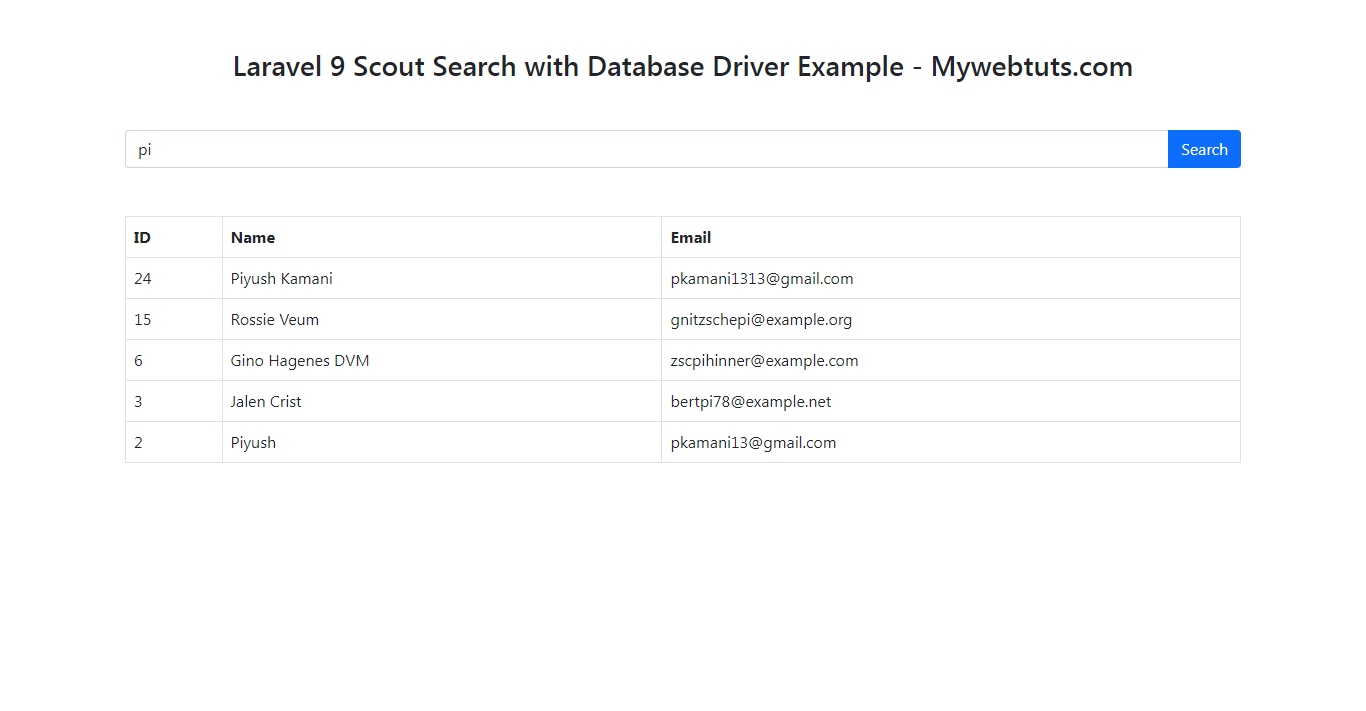Laravel 9 Scout Search with Database Driver Example
Mar 04, 2022 . Admin

Hi friends,
In this tutorial,i will tell Laravel 9 Scout Search with Database Driver Example. i will show the example of laravel 9 scout full text search. you can see laravel 9 scout search example. it can this example full explain scout full text search in laravel 9. Here you will learn how to add full text search in laravel 9 scout. you will learn laravel 9 scout elasticsearch example.
Let us know more about Laravel Scout, and it’s a powerful driver-based eloquent package that helps you develop super-fast fast-text search combining with your laravel models.
In this Laravel 9 Scout example, we will tell you how to process every ingredient to form the quick, responsive, and agile full-text search in laravel 9.
Here the following steps example laravel 9 full text search Using scout.
Step 1: Download LaravelLet us begin the tutorial by installing a new laravel application. if you have already created the project, then skip following step.
composer create-project laravel/laravel example-appStep 2: Install Scout
In this step we have to install scout package and we will publish them:
composer require laravel/scout
Next, we have to publish our configuration file. so you need to run bellow command:
php artisan vendor:publish --provider="Laravel\Scout\ScoutServiceProvider"
Now we need to set configuration database as driver in your env file:
.envSCOUT_DRIVER=databaseStep 3: Update User Model
Here, we already have users table created, so we need use "Searchable" and create toSearchableArray() method. so let's update following code:
app/Models/User.php
<?php
namespace App\Models;
use Illuminate\Contracts\Auth\MustVerifyEmail;
use Illuminate\Database\Eloquent\Factories\HasFactory;
use Illuminate\Foundation\Auth\User as Authenticatable;
use Illuminate\Notifications\Notifiable;
use Laravel\Sanctum\HasApiTokens;
use Laravel\Scout\Searchable;
class User extends Authenticatable
{
use HasApiTokens, HasFactory, Notifiable, Searchable;
/**
* The attributes that are mass assignable.
*
* @var string[]
*/
protected $fillable = [
'name',
'email',
'password',
];
/**
* The attributes that should be hidden for serialization.
*
* @var array
*/
protected $hidden = [
'password',
'remember_token',
];
/**
* The attributes that should be cast.
*
* @var array
*/
protected $casts = [
'email_verified_at' => 'datetime',
];
/**
* Get the indexable data array for the model.
*
* @return array
*/
public function toSearchableArray()
{
return [
'name' => $this->name,
'email' => $this->email
];
}
}
Next, we will create some dummy records on users table and import it.
so let's run following commands:
Create Dummy Records:
php artisan tinker User::factory()->count(20)->create()Import Records:
php artisan scout:import "App\Models\User"Step 4: Create UserController Controller
In this point, now we should create a new controller as UserController. In this controller, we will add index method, that will return users with filter.
Let's update following code to your controller file:
app/Http/Controllers/UserController.php
<?php
namespace App\Http\Controllers;
use Illuminate\Http\Request;
use App\Models\User;
class UserController extends Controller
{
/**
* Display a listing of the resource.
*
* @return \Illuminate\Http\Response
*/
public function index(Request $request)
{
if($request->filled('search')){
$users = User::search($request->search)->get();
}else{
$users = User::get()->take('5');
}
return view('users', compact('users'));
}
}
Step 5: Creat Route
In this is step we need to create route for listing users. so open your "routes/web.php" file and add following route.
routes/web.php
<?php
use Illuminate\Support\Facades\Route;
use App\Http\Controllers\UserController;
/*
|--------------------------------------------------------------------------
| Web Routes
|--------------------------------------------------------------------------
|
| Here is where you can register web routes for your application. These
| routes are loaded by the RouteServiceProvider within a group which
| contains the "web" middleware group. Now create something great!
|
*/
Route::get('users', [UserController::class, 'index']);
Step 6: Create View
In Last step, let's create users.blade.php(resources/views/users.blade.php) for layout and we will write design code here and put following code:
resources/views/users.blade.php
<!DOCTYPE html>
<html>
<head>
<title>Laravel 9 Scout Search with Database Driver Example - Mywebtuts.com</title>
<link href="https://cdnjs.cloudflare.com/ajax/libs/twitter-bootstrap/5.0.1/css/bootstrap.min.css" rel="stylesheet">
</head>
<body>
<div class="container">
<h3 class="mt-5 mb-5 text-center">Laravel 9 Scout Search with Database Driver Example - Mywebtuts.com</h3>
<form method="GET" class="mb-5">
<div class="input-group mb-3">
<input
type="text"
name="search"
value="{{ request()->get('search') }}"
class="form-control"
placeholder="Search..."
aria-label="Search"
aria-describedby="button-addon2">
<button class="btn btn-primary" type="submit" id="button-addon2">Search</button>
</div>
</form>
<table class="table table-bordered data-table">
<thead>
<tr>
<th>ID</th>
<th>Name</th>
<th>Email</th>
</tr>
</thead>
<tbody>
@foreach($users as $user)
<tr>
<td>{{ $user->id }}</td>
<td>{{ $user->name }}</td>
<td>{{ $user->email }}</td>
</tr>
@endforeach
</tbody>
</table>
</div>
</body>
</html>
Run Laravel App:
All steps have been done, now you have to type the given command and hit enter to run the laravel app:
php artisan serve
Now, you have to open web browser, type the given URL and view the app output:
http://localhost:8000/usersOutput:

I hope it can help you...
